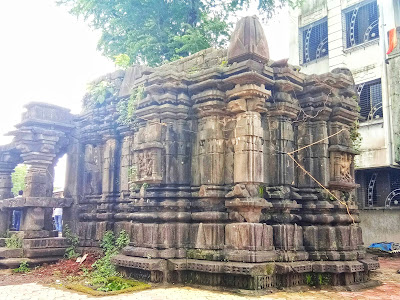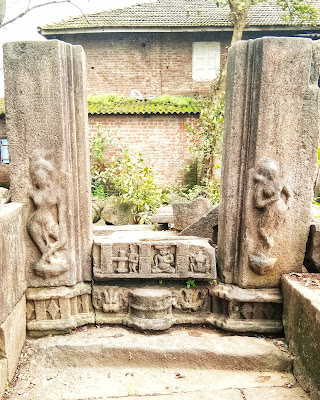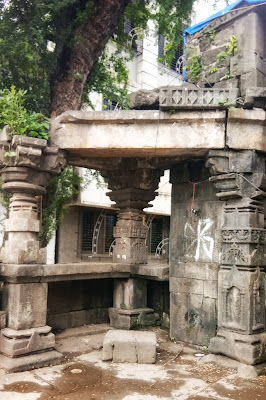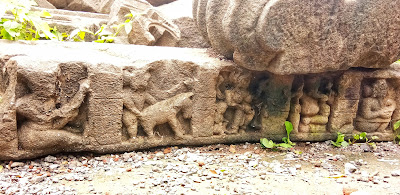Shiva temple Lonad is popularly known as Someshwar temple. This temple was built in the 1st
century AD. It is the time when the Thane and northern Konkan were ruled by
Shilahara. The Shilahara were Shiva worshipers. At present, this temple is used
by locals to worship. The residence of the Lonad regularly visits the temple to
keep it as clean as possible.
The earlier reference of
this temple is in the inscriptions of the Vasai, dated in shaka 1161 (A.D.
1239-40). It states that Keshideva was a son of Apararka and record the grant
of a field or hamlet name Bapagrama (Babgaon and Lonad) to four worshipers of
Shiva temple. Another one refers to the jirnodhhara
(repairs) of the Shiva temple and the gift of the garden in Lona (Lonad).
 |
| The backside of the temple showing different layers and carvings. |
This temple was built of well-dressed slabs of stone of trap fitted without mortar and with cross corner dome. The temple is entered in the east and the shrine is in the west. In front of the main sanctuary, there was a hall (Mandapa) with the central dome. According to the local, there used to be the three sanctums, one left to the main shrine and another is at right to the main shrine. There are no traces of the entrance porch to the temple. This is a bhomij style temple (the temple where shikhara starts from the ground and garbhagriha is at lower than the ground level). Above the door, which leads to the main shrine which is 5-6 steps below the ground level, there is a beautiful and intricate carved panel showing the Shiva in various forms.
The dome above the garbhagriga
has a simple design but due to weathering of the stones, it began to disappear.
But the cracks in the stone are fairly visible. In the inner sanctum of the
temple, there is Shiva Linga and Nandi at the centre and at one corner there is
Ganesh idol. There is another Shiva Linga at the left side but it seems like it
placed there much later.
The outer structure of the temple is ruined but the inner sanctum is in good condition. The roof of the mandapa has been fallen and carried away. There are only a few traces of the outer rim of the dome are remain.
Behind
the temple, there is a water body. The temple is adorned with the beautiful
carving on pillars and the panels above the doorway. The broken parts of the
temples are spreader on the premises. Carving on the pillars can be still seen.
There are carving including Ganesha, Lajjagauri, Ratnapattika, Gajapattika
and other broken statues.
The shilahara seems to have been fond of the buildings. The Mohammedans at the beginning of the 13th century and Portuguese in the 16th century destroyed temples and the Shiva temple Lonad is one of the examples among these. The statements of travellers and remains of the temples prove that the masonry was of well-dressed and closed fitting blocks of stone. The sculpture was carved with skill and richness. Many of them seem to have disfigured by indecency.
References:
https://merwynsrucksack.blogspot.com/2015/04/lonad-caves-and-shiva-temple-in-lonad.html?m=0
http://historicfortsofindia.blogspot.com/2017/08/lonad-caves-thane.html
https://bijoor.me/2013/08/01/cycling-to-lonad-caves-and-shiva-temple/
https://cultural.maharashtra.gov.in/english/gazetteer/Thane/Ancient-Period.html
https://historyrktcollege.wordpress.com/category/our-field-visits/




















Comments
Post a Comment